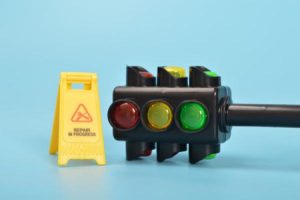 There are many features both in your car and on and along the roadway that are intended to keep you safe. Sometimes, you might not notice those features until you are deprived of them. One such example is lighting. There are a variety of lights intended to keep you safe while driving: head lights, taillights, streetlights, and stoplights, for example.
There are many features both in your car and on and along the roadway that are intended to keep you safe. Sometimes, you might not notice those features until you are deprived of them. One such example is lighting. There are a variety of lights intended to keep you safe while driving: head lights, taillights, streetlights, and stoplights, for example.
When one or more of those features fails or you run into an unfamiliar lighting situation, you shouldn’t panic. Instead, follow the below advice on how to safely navigate these situations:
Navigating Traffic Signal Malfunctions
Flashing Yellow Light
Sometimes, you’ll come to what is usually a normal stoplight and see it flashing yellow. This is essentially a caution sign. It advises drivers to slow down and proceed with heightened caution. While you don’t have to stop unless necessary, always be prepared for vehicles or pedestrians who might be unaware or confused by the signal.
Flashing Red Light
When confronted with a flashing red light, treat it the same as a stop sign. Come to a complete halt, check all directions, and proceed only when it’s safe. If multiple vehicles arrive at the intersection, the one on the right has the right of way, similar to four-way stop sign rules.
Stoplight/ Traffic Signal Outage
If you approach an intersection where the stoplights are completely out, it can be a bit unnerving. By United States law you are to treat it as a four-way stop. This means each driver should stop before proceeding through the intersection. If two vehicles reach the intersection simultaneously, the driver on the left should yield to the driver on the right.
There are few things worse than driving at night amid a traffic signal outage. If you find yourself in that position, it’s best to slow down and pay extra attention to your surroundings.
Handling Your Car’s Lighting Issues
Driving with malfunctioning vehicle lights, especially in low-visibility conditions, is dangerous. The best way to avoid this is to take steps to prevent it. Before heading out, especially for long journeys or nighttime drives, inspect all your vehicle lights: headlights, taillights, brake lights, and indicators. Keeping spare bulbs in your vehicle is also proactive step. It might just save the day when you find a light has burnt out mid-journey.
If you identify a lighting malfunction while driving, try to reach a safe spot, such as a well-lit parking area. If you can’t replace the bulb yourself, seek professional assistance as soon as possible.
When lighting malfunctions occur on the road, it’s crucial to remain calm and prioritize safety. In the unfortunate event of an accident, understanding the exact circumstances that led up to it can be pivotal. Sophisticated tools, including forensic car accident reconstruction software from 4N6XPRT Systems, can provide valuable insights. Our software is highly accurate, providing you with the information you need for court, insurance, or other purposes. To learn more, give us a call at 619-464-3478 today!

